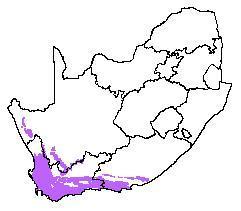THE FYNBOS BIOME (comprising Fynbos & Renosterveld)
Fynbos Biome

The Fynbos Biome is considered by many to be synonymous with the Cape Floristic Region or Cape Floral Kingdom. However, the "biome" refers only to the two key vegetation groups (Fynbos and Renosterveld) within the region, whereas both the "region" and the "kingdom" refer to the general geographical area and include other vegetation types in the Forest, Nama Karoo, Succulent Karoo and Thicket Biomes, but exclude peripheral outliers of the Fynbos Biome such as the Kamiesberg, North-western and Escarpment Mountain Renosterveld and Grassy Fynbos east of Port Elizabeth. However, the contribution of Fynbos vegetation to the species richness, endemicity and fame of the region is so overwhelming, that the Cape Floristic Region and Cape Floral Kingdom can be considered to be "essentially Fynbos."
The Cape Floral Kingdom is the smallest of the six Floral Kingdoms in the world, and is the only one contained in its entirety within a single country. It is characterized by its high richness in plant species (9 003 species) and its high endemicity (68% of plant species are confined to the Cape Floral Kingdom). The Cape Floral Kingdom thus compares with some of the richest floras worldwide, surpassing many tropical forest regions in its floral diversity.
In South Africa, over half of all plant species occur in the Cape Floral Kingdom, even though the Kingdom occupies less than 6% of the area of the country. (One in every 5 species of plant in Africa is confined to the Kingdom - in 0.6% of the area!) This is not primarily due to the large number of vegetation types in the Cape Floral Kingdom. Over 7 000 of the plant species occur in only five Fynbos vegetation types, with perhaps an additional 1 000 species in the three Renosterveld vegetation types. The contribution of Succulent and Nama Karoo, Thicket and Forest vegetation types in the region to the plant species diversity is thus relatively small. Thus, although the Cape Floral Kingdom contains five biomes, only the Fynbos Biome, comprising the Fynbos and Renosterveld vegetation groups, contains most of the floral diversity. Furthermore, the Cape Floral Kingdom traditionally does not include the Fynbos and Renosterveld vegetation outliers to the north and east. Including these would mean that endemicity would approach 80%, the highest level of endemicity on any subcontinent.
Distressingly, some three-quarters of all plants in the South African Red Data Book occur in the Cape Floral Kingdom: 1 700 plant species are threatened to some extent with extinction! This is much more than one would expect based on either the area of the Kingdom (6%) or its plant numbers (50%). This again reflects the unique nature of Fynbos vegetation: many Fynbos species are extremely localized in their distribution, with sets of such localized species organized into "centres of endemism." The city of Cape Town sits squarely on two such centres of endemism and several hundred species are threatened by urban expansion.
However, a more serious threat is alien plants, which infest large tracts of otherwise undisturbed mountains and flats: their impact on these extremely localized species is severe. Aliens are thus the major threat to Fynbos vegetation and its plant diversity, especially in the mountains. On the lowlands and on the less steep slopes the major threat is agriculture - new technologies, fertilizers and crops are steadily eating into our floral reserves. Another important threat is the misuse of fire. Fynbos must bum, but fires in the wrong season (such as in spring, instead of late summer) or too frequently (so that plants do not have time to set seed) eliminate species. Several factors influence fire dynamics in Fynbos: global warming, grazing practices and fire management (ignition events, size of burns), but their relative importance and interactions are poorly understood.
The two major vegetation groupings in Fynbos are quite distinct and have contrasting ecological systems. Essentially, Renosterveld used to contain the large animals in the Cape Floristic Kingdom, but these are now extinct or else have been reintroduced into conservation areas. By contrast, Fynbos is much richer in plant species, but has such poor soils that it cannot support even low densities of big game. However, most of the endemic amphibian, bird and mammal species in the region, occur in Fynbos vegetation types.
Please see more on:
Fynbos at https://www.inaturalist.org/posts/13032-fynbos
Renosterveld at https://www.inaturalist.org/posts/13033-renosterveld
Source: Low, A.B. & Rebelo, A.(T.) G. 1998. Vegetation of South Africa, Lesotho and. Swaziland, edn 2. Dept of Environmental Affairs and Tourism, Pretoria.





Comments
Thanks for these posts Tony, gives me a good feel for the biomes!
Very interesting and complete series on the South African Biomes. I am still astonished at how such a small and non-tropical place can be so diverse! I live in Colombia, which is itself a megadiverse country, with some 25.000 vascular plant species recorded. Anyway, I think we have a lesser degree of country endemics than you do (less than 25% here). It is also interesting to see how a shrub-dominated ecosystem harbors more species than many forests. Here in Colombia, forests of many kinds are usually the dominant natural ecosystem and conservation activities tend to focus on forest conservation... buy we have shrublands too and sometimes I feel that (except for the paramo highlands) they are overlooked as valuable conservation assets. I´ll be reading the other Biome posts... it´s very stimulant to compare the affinities and differences with the ecosystems and species we have here...
(By the way, our mountain shrublands also show an abundance of Asteraceae species and many ericoids too... most of our 22 species of Proteaceae, on the other hand, are mature forest trees and not usually present in shrubby areas...)
Can you make the list of habitats on the right hand column of the Project page a link to the observations? For example: Fynbos
I can email you the marked up URLs so you need only paste them in.
Is it what you want?
perfect. tks!
Add a Comment